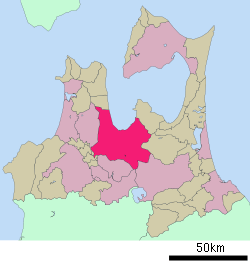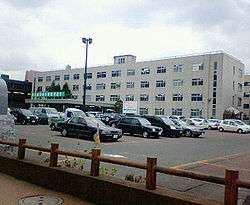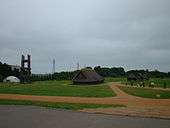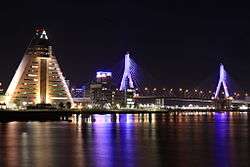Aomori, Aomori
| Aomori 青森市 | |||
|---|---|---|---|
| Core City | |||
|
Aomori Prefecture Tourist Center (left) and Aomori Bay Bridge (right) | |||
| |||
 Location of Aomori in Aomori Prefecture | |||
 Aomori
| |||
| Coordinates: 40°49′20.4″N 140°43′50.6″E / 40.822333°N 140.730722°ECoordinates: 40°49′20.4″N 140°43′50.6″E / 40.822333°N 140.730722°E | |||
| Country | Japan | ||
| Region | Tōhoku | ||
| Prefecture | Aomori Prefecture | ||
| Government | |||
| • Mayor | Hiroshi Shikanai | ||
| Area | |||
| • Total | 824.61 km2 (318.38 sq mi) | ||
| Elevation | 2 m (7 ft) | ||
| Population (September 2015) | |||
| • Total | 288,029 | ||
| • Density | 349/km2 (900/sq mi) | ||
| Time zone | Japan Standard Time (UTC+9) | ||
| City symbols | |||
| • Tree | Maries' fir | ||
| • Flower | Rosa rugosa | ||
| • Bird | Ural owl | ||
| • Insect | Firefly | ||
| Phone number | 017-734-1111 | ||
| Address | 1-22-5 Chūō, Aomori-shi, Aomori-ken 030-8555 | ||
| Website | City of Aomori | ||

Aomori (青森市 Aomori-shi) is the capital city of Aomori Prefecture, in the northern Tōhoku region of northern Japan. As of September 2015, the city had an estimated population of 288,029 and a population density of 349 persons per km2. The total area of the city was 824.61 square kilometres (318.38 sq mi).
History
Aomori literally means blue forest, although it could possibly be translated as "green forest". The name is generally considered to refer to a small forest on a hill which existed near the town. This forest was often used by fishermen as a landmark. A different theory suggests the name might have been derived from the Ainu language.

The area has been settled extensively since prehistoric times, and numerous Jōmon period sites have been found by archaeologists, the most famous being the Sannai-Maruyama Ruins located just southwest of the city center dating to 5500-4000 BC, and the Komakino site slightly further south dating to around 4000 BC. The large scale of these settlements revolutionized theories on Jōmon period civilization. During the Heian period, the area was part of the holdings of the Northern Fujiwara clan, but remained inhabited by the Emishi people well into the historic period. After the fall of the Northern Fujiwara in the Kamakura period, the territory was part of the domain assigned to the Nambu clan, and into the Sengoku period, it came under the control of the rival Tsugaru clan, whose main castle was located in Namioka. After the start of the Edo period, Aomori was a minor port settlement for Hirosaki Domain called Utō (善知鳥村 Utō-mura). The town was rebuilt in 1626 by Moriyama Yashichirō, under orders of the daimyō, Tsugaru Nobuhira and renamed Aomori, but the name did not come into common use until after 1783.
After the Meiji Restoration the various domains were abolished and replaced with prefectures, a total of six in the territory of modern Aomori Prefecture. These were merged into the short-lived Hirosaki Prefecture in July 1871. However, due to the historic enmity between the former Tsugaru territories in the west and the former Nambu territories in the east, the prefectural capital relocated from Hirosaki to the more centrally-located Aomori immediately after the merger and the prefecture was renamed Aomori Prefecture on September 23, 1871. However, Aomori was not given town status within Higashitsugaru District until April 1, 1889, and was not designated a city until April 1, 1898.
The Hokkaidō Colonization Office began operations of a ferry service from Aomori to Hakodate in Hokkaido from 1872. In September 1891, Aomori was connected with Tokyo by rail with the opening of the Tōhoku Main Line. The Ōu Main Line running along the Sea of Japan coast opened in December 1894. The development of modern Aomori was primarily due to its prefectural capital status and the singular importance as the terminus of these rail lines and the Seikan Ferry, which officially opened in 1908. The 8th Division of the Imperial Japanese Army were stationed in Aomori from 1896. In the winter of 1902, 199 of 210 soldiers on a military cold-weather readiness exercise perished while attempting to cross the Hakkōda Mountains from Aomori to Towada in what was later called the Hakkōda Mountains incident.
Much of the town burned down in a large fire on May 3, 1910. The port facilities were expanded in 1924, and the city received its first bus services in 1926. Japan Air Transport began scheduled air services from 1937.
Towards the final stages of World War II, on the night of July 28–29, 1945, Aomori was subject to an air raid as part of the strategic bombing campaign waged by the United States of America against military and civilian targets and population centers during the Japan home islands campaign. The July 28–29 bombing claimed 1,767 lives and destroyed 88% of the city.
In the post war period, Aomori rebuilt as the local political and commercial center. The Tsugaru Line railway opened in 1951, and Aomori Airport in 1964. The city was connected to Tokyo by highway in 1979 with the opening of the Tōhoku Expressway. Aomori’s landmark pyramidal Aomori Prefectural Tourist Center opened in 1986. On October 1, 2002, Aomori was proclaimed a core city with increased autonomy from the central government.
On April 1, 2005, the town of Namioka was merged into Aomori; but lost a portion of Namioka to the town of Fujisaki (from Minamitsugaru District) on September 1, 2007.
Geography
Aomori is located in central Aomori Prefecture, between the southern end of Mutsu Bay, which it faces to the north and the Hakkōda Mountains to the south.
Neighbouring municipalities
- Aomori Prefecture
Climate
Like most of Tōhoku, Aomori has a humid temperate climate with warm summers, and cold, though not extreme, winters. The city has ahumid continental climate (Köppen Dfa), with monthly averages ranging from −1.2 °C (29.8 °F) in January to 23.3 °C (73.9 °F) in August.
Aomori and its surrounding area are renowned for heavy snowfall, the heaviest among all Japanese cities, and, in fact, among the heaviest in the world. In February 1945 the city recorded a maximum snow cover of 209 centimetres (82 in), but the extreme low of −24.7 °C (−12 °F) was recorded 14 years earlier. In contrast, Sapporo's heaviest snowfall occurred in 1939, and that was only 164 centimetres (65 in), and more northerly Wakkanai has recorded similar maxima. The particularly heavy snow is caused by several winds that collide around the city that makes the air rise and cool, resulting in quick, thick cloud formation followed by intense precipitation.
In summer, a cool wind called Yamase often blows from the east, which sometimes results in abnormally cool weather and poor harvests. Additionally, thick fogs from the Oyashio Current are often observed in mountainous areas in the summer. Due to this fog, flights to Aomori Airport are often cancelled.
| Climate data for Aomori, Aomori | |||||||||||||
|---|---|---|---|---|---|---|---|---|---|---|---|---|---|
| Month | Jan | Feb | Mar | Apr | May | Jun | Jul | Aug | Sep | Oct | Nov | Dec | Year |
| Record high °C (°F) | 13.5 (56.3) |
17.1 (62.8) |
20.1 (68.2) |
28.3 (82.9) |
31.3 (88.3) |
33.5 (92.3) |
35.4 (95.7) |
36.7 (98.1) |
36.1 (97) |
30.5 (86.9) |
23.8 (74.8) |
21.1 (70) |
36.7 (98.1) |
| Average high °C (°F) | 1.6 (34.9) |
2.3 (36.1) |
6.3 (43.3) |
13.5 (56.3) |
18.4 (65.1) |
21.7 (71.1) |
25.4 (77.7) |
27.7 (81.9) |
24.0 (75.2) |
18.0 (64.4) |
10.9 (51.6) |
4.6 (40.3) |
14.5 (58.1) |
| Daily mean °C (°F) | −1.2 (29.8) |
−0.7 (30.7) |
2.4 (36.3) |
8.3 (46.9) |
13.3 (55.9) |
17.2 (63) |
21.1 (70) |
23.3 (73.9) |
19.3 (66.7) |
13.1 (55.6) |
6.8 (44.2) |
1.5 (34.7) |
10.4 (50.7) |
| Average low °C (°F) | −3.9 (25) |
−3.7 (25.3) |
−1.3 (29.7) |
3.7 (38.7) |
8.9 (48) |
13.5 (56.3) |
18.0 (64.4) |
19.8 (67.6) |
15.1 (59.2) |
8.6 (47.5) |
3.0 (37.4) |
−1.4 (29.5) |
6.7 (44.1) |
| Record low °C (°F) | −23.5 (−10.3) |
−24.7 (−12.5) |
−18.4 (−1.1) |
−12.2 (10) |
−1.4 (29.5) |
4.0 (39.2) |
6.5 (43.7) |
8.9 (48) |
3.0 (37.4) |
−2.4 (27.7) |
−12.1 (10.2) |
−20.6 (−5.1) |
−24.7 (−12.5) |
| Average precipitation mm (inches) | 144.9 (5.705) |
111.0 (4.37) |
69.9 (2.752) |
63.4 (2.496) |
80.6 (3.173) |
75.6 (2.976) |
117.0 (4.606) |
122.7 (4.831) |
122.7 (4.831) |
103.9 (4.091) |
137.7 (5.421) |
150.8 (5.937) |
1,300.1 (51.185) |
| Average snowfall cm (inches) | 225 (88.6) |
176 (69.3) |
76 (29.9) |
6 (2.4) |
0 (0) |
0 (0) |
0 (0) |
0 (0) |
0 (0) |
0 (0) |
32 (12.6) |
153 (60.2) |
669 (263.4) |
| Average precipitation days (≥ 0.5 mm) | 24.3 | 20.7 | 16.7 | 11.2 | 11.5 | 9.4 | 10.3 | 10.7 | 11.8 | 14.5 | 18.8 | 23.3 | 183.2 |
| Average snowy days | 28.5 | 24.2 | 19.5 | 3.3 | 0 | 0 | 0 | 0 | 0 | 0.4 | 9.4 | 23.1 | 108.4 |
| Average relative humidity (%) | 78 | 76 | 69 | 66 | 70 | 78 | 80 | 79 | 76 | 73 | 72 | 77 | 74.5 |
| Mean monthly sunshine hours | 51.3 | 69.8 | 130.5 | 182.3 | 201.1 | 179.6 | 159.5 | 180.3 | 158.4 | 149.7 | 87.6 | 52.8 | 1,602.7 |
| Source #1: 気象庁[1] | |||||||||||||
| Source #2: Kishōchō[2] | |||||||||||||
Economy
Aomori serves as the regional commercial center for central Aomori Prefecture. Agriculture and commercial fishing form only 4% of the city economy, with manufacturing forming 16.2% and the service sector forming 78.2%.
Transportation
Airport
- Aomori Airport - (established in 1964 with international flights from 1995) is about a 35-minute drive from the city centre, with a bus service available. There are daily flights to Tokyo, Osaka, Nagoya and Sapporo. There are also flights to Seoul, South Korea three times per week.
Railways
Aomori Station has been the main station of the city since 1891. The two trunk lines of the Tōhoku region, the Tōhoku Main Line (now Aoimori Railway) and the Ōu Main Line, terminated at Aomori Station and were continued to Hakodate by the Seikan Ferry. In 1988, Seikan Tunnel replaced the ferry, but the station was still the connecting point between main line trains and trains for Aomori-Hakodate section.
The Tōhoku Shinkansen opened in 2010 with a new terminal at Shin-Aomori Station. The Shinkansen provides High-speed service between Shin-Aomori, Hachinohe, Morioka, Sendai and Tokyo.
- East Japan Railway Company (JR East) - Tōhoku Shinkansen (opened December 4, 2010)
- Station in the city: Shin-Aomori
- JR East - Ōu Main Line
- Stations in the city: Aomori, Shin-Aomori, Tsugaru-Shinjō, Tsurugasaka, Daishaka, Namioka
- JR East - Tsugaru Line
- Stations in the city: Aomori, Aburakawa, Tsugaru-Miyata, Okunai, Hidariseki, Ushirogata, Nakasawa
- Aoimori Railway Line
- Stations in the city: Aomori, Higashi-Aomori, Koyanagi, Yadamae, Nonai, Asamushi-Onsen
Highways
- Tōhoku Expressway
- Aomori Expressway
- Japan National Route 4
- Japan National Route 7
- Japan National Route 101
- Japan National Route 103
- Japan National Route 280
- Japan National Route 394

Seaports
- Port of Aomori - The Seikan Ferry operates ferries to Hakodate. It takes about four hours to go by ferry from Aomori to Hakodate. The ferry was initially run by the Ministry of Railroads but was later taken over by Japanese National Railways. From 1908 to 1988 the ferry served as the primary transport between the island of Honshū and the northern island of Hokkaido. In March 1988, the Seikan Tunnel opened up, travelling under the Tsugaru Strait, this quickly replaced the slow-moving ferry as the primary transportation between the two islands.
Education
Aomori is the only prefectural capital in Japan which has no national university, instead, nearby Hirosaki became the site for the prefecture's highest educational facility.
Universities and colleges
High schools
|
Junior high schools
|
Local attractions

- Aomori Nebuta is a famous festival performed from August 2–7 annually and is listed as one of the 100 Soundscapes of Japan by the Japanese Ministry of the Environment.[3]
Besides this, major attractions of Aomori include ruins, museums, and mountains. The Hakkōda Mountains have good locations for trekking with hot spas (onsen), such as Sukayu Onsen.
- Asamushi Aquarium
- Asamushi Onsen
- Aomori Museum of Art
- Aomori City Forestry Museum
- Aomori Prefectural Museum
- Aomori City History and Folk Arts Museum
- Munakata Shiko Memorial Museum of Art
- Nebuta-no-sato Museum
- Sannai-Maruyama Ruins
- Seiryū-ji
Sports
Aomori has hosted several international curling events, two in 2003 (including the Asian Winter Games), and the local women's "Team Aomori" was selected to represent Japan at the 2006 Winter Olympics in Turin, Italy and at the 2010 Winter Olympics in Vancouver, British Columbia, Canada. From March 17–25, 2007, Aomori hosted the World Women's Curling Championships.
Sister city relations
 - Hakodate, Hokkaido – since 1989
- Hakodate, Hokkaido – since 1989 - Kecskemét, Bács-Kiskun County, Hungary[4] – since August 1994
- Kecskemét, Bács-Kiskun County, Hungary[4] – since August 1994 - Pyeongtaek, Gyeonggi-do, South Korea[4] – since 1995
- Pyeongtaek, Gyeonggi-do, South Korea[4] – since 1995 – Dalian, Liaoning, China[4] – since December 2004
– Dalian, Liaoning, China[4] – since December 2004 - Hsinchu County, Taiwan[4] - friendship city since October 2014
- Hsinchu County, Taiwan[4] - friendship city since October 2014
Notables from Aomori
- Noriko Awaya – singer
- Takaharu Furukawa – archer
- Takanori Hatakeyama – professional boxer
- Yuji Hayami – science-fiction writer
- Shigeru Izumiya – entertainer
- Yaho Kitabatake – children's fiction writer
- Ichirō Kojima – photographer
- Daimaou Kosaka - comedian
- Keizo Miura – skier
- Yuichiro Miura – skier
- Shiko Munakata – woodblock artist
- Hitoshi Saito – judoka
- Kyoichi Sawada – photographer
- Akimitsu Takagi – crime fiction writer
- Bushuyama Takashi – sumo wrestler
- Kiyoshi Tanabe – professional boxer
- Shūji Terayama – modern artist
- Takanosato Toshihide – sumo wrestler
- Akiko Yano – singer-songwriter
- Daisuke Matsuzaka – Baseball player
References
- ↑ "平年値(年・月ごとの値)". Kishōchō. Retrieved Jan 11, 2010.
- ↑ "観測史上1~10位の値(年間を通じての値)". Kishōchō. Retrieved Jan 11, 2010.
- ↑ "100 Soundscapes of Japan". Ministry of the Environment. Retrieved 8 December 2015.
- 1 2 3 4 "International Exchange". List of Affiliation Partners within Prefectures. Council of Local Authorities for International Relations (CLAIR). Retrieved 8 December 2015.
External links
| Wikimedia Commons has media related to Aomori. |
| Wikivoyage has a travel guide for Aomori. |
- Aomori City official website (Japanese)
- Aomori City official website
- The 5th Winter Asian Games AOMORI 2003
- Sannai-Maruyama Site official website
- Pictures of Aomori, Japan ( Aomori city, Aomori Bay Bridge )
- Photos, report and advice about Nebuta Matsuri, Aomori's famous festival (one of the most famous festivals in Japan)



